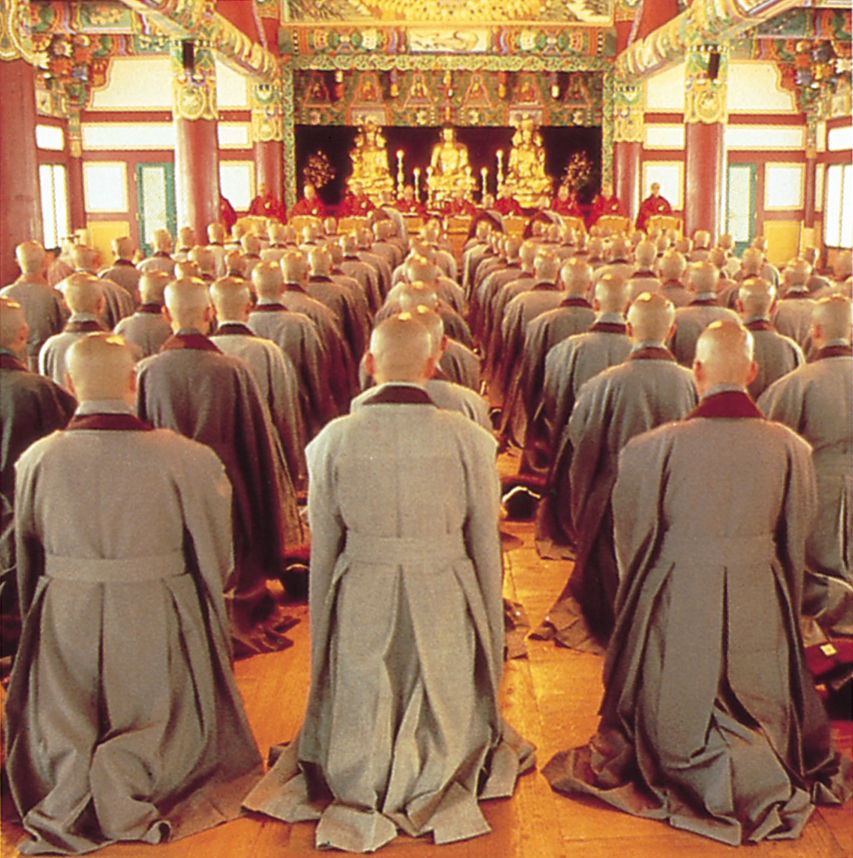Monasticism, << muh NAS tuh sihz uhm, >> is a special form of religious community life. People who practice monasticism separate themselves from ordinary ways of living so they can follow the teachings of their religion as completely as possible. Men who adopt a monastic life are called monks and live in a monastery. Monastic women are called nuns and live in a convent.

Monasticism has an important part in several major religions. The word comes from the Greek word monos, meaning alone. The first Christian monastics were called ones who live alone because they lived by themselves in the desert. Later, groups of them gathered together and formed communities that followed a life of prayer and self-discipline. Today, the members of monastic communities also follow this kind of life.
Christian monasticism
began in Egypt about A.D. 271, when Saint Anthony of Thebes went alone into the desert to lead a holy life. Others soon followed. In the early 300’s, Saint Pachomius, another desert holy man, gathered some of these hermits into monasteries.
Monasticism became especially influential in Europe during the early Middle Ages. At that time, Europe had thousands of monasteries that were great centers of learning. After about 1200, however, Christian monasticism began to be replaced by orders of wandering friars. It has never regained its former influence. See Middle Ages (The Christian church) .
Life in a Christian monastic community involves work, prayer, and meditation. A monastery or convent may be in a rural area or in a city. It may consist of a small, walled-in group of huts or a huge complex that houses hundreds of people. But it is designed to isolate its people from the world outside. Christian monasticism also includes an extremely important element called the rule, a set of guidelines by which members of a monastic group live. Its essential purpose is to set specific times each day for study, work, prayer, and other activities. Eastern Orthodox monastic groups base their rule on the teachings of Saint Basil of Caesarea, who lived in the 300’s. The Rule of Saint Benedict of Nursia, written in the 500’s, is the model for most Roman Catholic groups.
In addition to following a rule, Christian monks and nuns take three vows–poverty, chastity, and obedience. The vow of poverty requires a person not to own any private possessions. The vow of chastity obligates a monk or nun to have no sexual relations. The vow of obedience requires a person to always follow the decisions of the leader of the monastic community.
There are several Christian monastic orders. Each of these groups of monasteries or convents follows the same rule and shares a common leadership. There are also many nonmonastic orders. The members of these groups dedicate their lives to preaching and service, rather than to prayer and meditation.
Non-Christian monasticism.
A number of non-Christian religions also have monastic communities. For example, monasticism in Buddhism began in the 500’s B.C., about 800 years before Christian monasticism. Buddha, the founder of the religion, taught his followers to give up their family, work, and material things. Early Buddhist monks and nuns spent most of their time as wandering mendicants (holy beggars). Today, few Buddhist nuns are left, and most Buddhist monks live in monasteries. A highly detailed rule called the Vinaya guides everything they do. See Buddhism .
The monks and nuns of Jainism, an ancient religion of India, still live much as the first Buddhist monastics did. They are wandering mendicants who lead extremely strict lives and strive never to harm any living creature, not even an insect. See Jainism .
Hinduism has had religious hermits since ancient times. But they were never well organized until about A.D. 800, when a great teacher named Sankara founded an order with four monasteries. Since then, about 10 large orders and many small ones have developed.
The influence of monasticism today
has declined almost everywhere. Perhaps the chief reason for this decline has been widespread secularism (doubt of the value of religion). Christian monastic groups have lost members who question the value of the traditional vows, especially the vow of chastity. In addition, Communist governments have persecuted Buddhist monastics in China, Tibet, and parts of Southeast Asia. Most Hindu monastic orders also have fewer members.
On the other hand, there has been renewed interest in monasticism among some religious groups. The Ramakrishna Mission, a modern Hindu order involved in social work, has attracted a large following in India and in other parts of the world. Tibetan Buddhist exiles have founded successful monasteries in the United States. The Lutheran and Dutch Reformed churches and several other Protestant groups have also started monastic communities.
